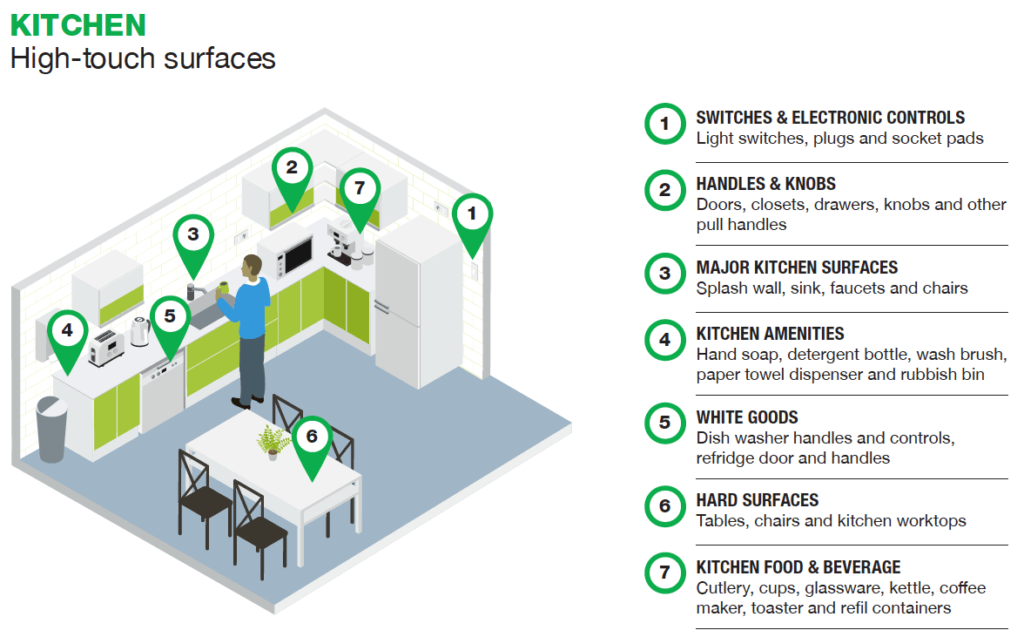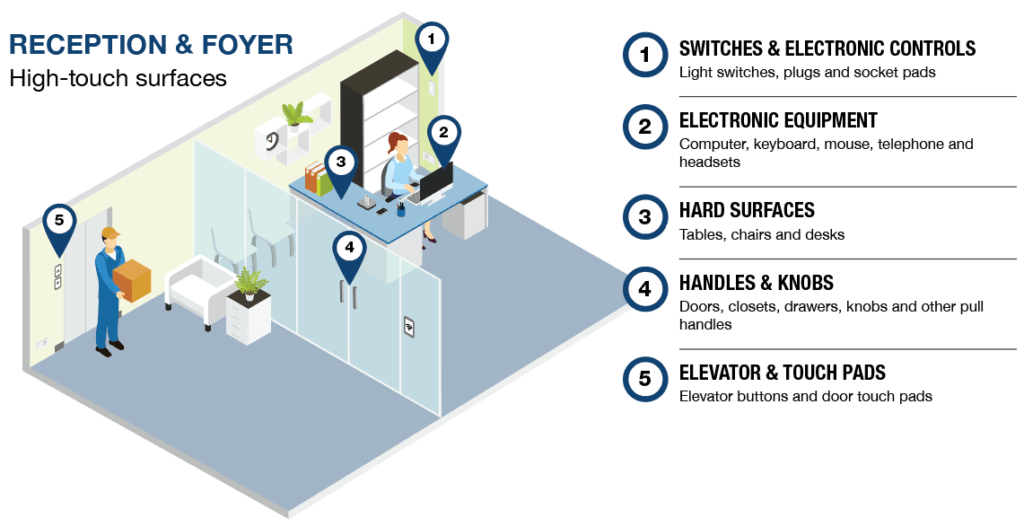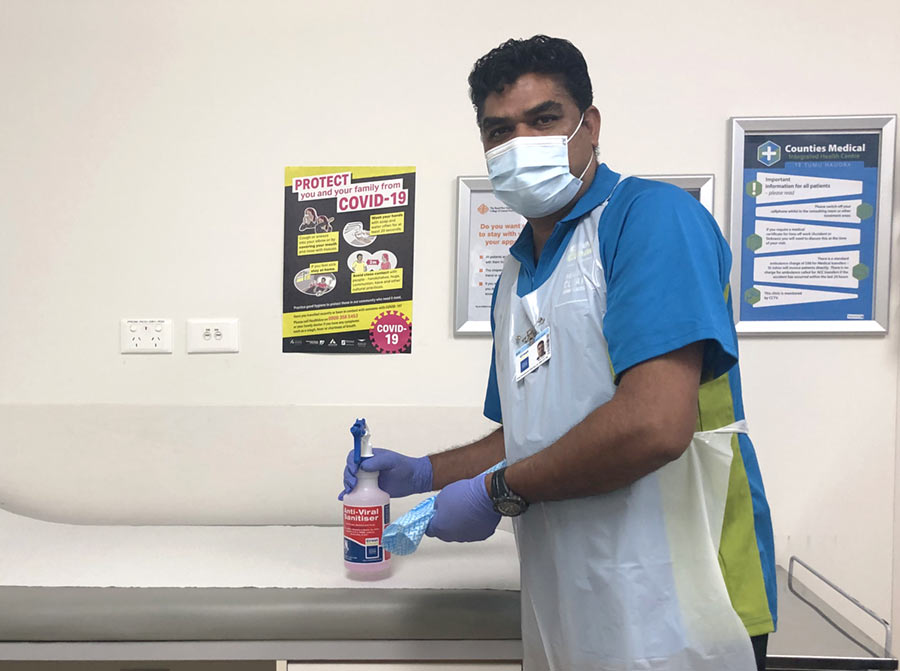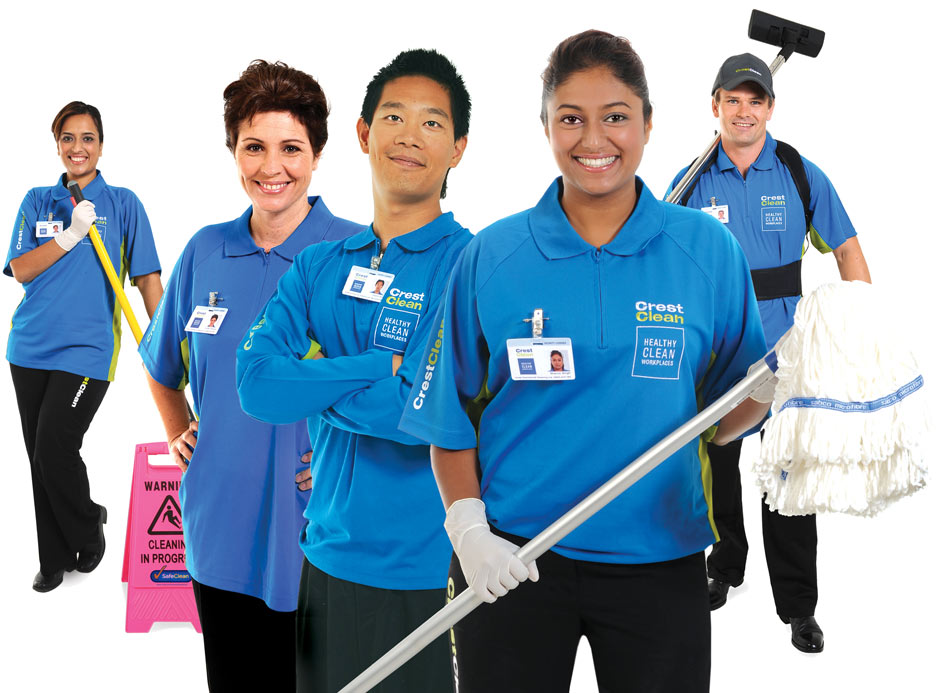Sanitising High-Touch Surfaces
Minimise the potential transmission of viruses and bacteria
It has never been more important to maintain healthy indoor environments to allow people to return to their respective organisations with confidence.
The effective sanitisation of high-touch surfaces is a key component of any cleaning regime in a pandemic situation and beyond.
What are high-touch surfaces?
High-touch surfaces are hard surfaces that are frequently touched by a number of people during the course of a day.
These surfaces are generally found in high traffic areas of indoor environments and include reception areas, offices, kitchens and bathrooms.
Below is a list of common high-touch surfaces that should be regularly sanitised:
- Reception counters
- Desks
- Kitchen bench tops and tables
- Appliances such as microwaves or refrigerators
- Bathroom dispensers
- Taps
- Door handles
- Rubbish bin lids

Why is the sanitising of touch surfaces so important?
Regular cleaning and sanitising of high-touch surfaces with anti-viral sanitiser is an effective way to optimise the health of indoor environments.
Cleaning prevents the build-up of soil, dust, or other materials that can carry pathogens and support their growth. There is a risk of spreading pathogens instead of reducing them if cleaning is not properly performed.
Pathogens can include bacteria, fungi or viruses, including the coronivirus and other strains of flu viruses.
Notable pathogens killed by CrestClean’s EPA registered Anti-Viral Sanitiser
| Human Viruses | Bacteria | Fungi |
|---|---|---|
| SARS-CoV-2, the novel coronavirus that causes COVID-19 | Pseudomonas aeruginosa1 | Aspergillus niger |
| Staphylococcus aureus1 | Candida albicans | |
| Human Coronavirus | Salmonella choleraesuis | richophyton mentagrophytes (Athlete’s foot fungus and a cause of ringworm) |
| Influenza A Virus / Hong Kong | Chlamydia psittaci | |
| HIV-1 (AIDS Virus) | Enterobacter aerogenes | |
| Hepatitis B Virus (HBV) | Legionella pneumophila | |
| Hepatitis C Virus (HCV) | Salmonella enteritidis | |
| Herpes Simplex Type 1 | Salmonella typhi |
Surfaces in the office kitchen. A bacteria cafeteria?
Office kitchen areas receive a lot of heavy traffic. Employees are constantly coming in and out of this area to get hot drinks, fill up a water bottle, or prepare snacks.
While people are making a cup of coffee or preparing a meal, they can touch a multitude of surfaces and appliances.
Areas that can become ‘germ magnets’ include cabinet knobs, faucets, and refrigerator doors.
In fact, employees may be carrying germs from other areas of the office to these areas. Researchers have found that computers and desks are among the dirtiest places in an office.
Employees could easily transfer germs from their keyboard to the coffee machine when they go on a quick break.

Does the office reception area welcome germs?
A busy office will likely see a hefty amount of foot traffic coming through the front door. From courier deliveries, staff arrivals, and business associates, all potentially tracking in their own germs.
The potential risk begins on arrival: they touch the door, and sign in at the reception and then invariably there’s a handshake greeting.
As shown in the diagram (right) high-touch points include: lift buttons, door handles, push plates, and knobs. These areas should be treated with an Anti-Viral Sanitiser.

Advice from leading microbiologist on workplace hygiene and sanitisation
Acclaimed microbiologist Dr Charles Gerba has an international reputation for his methodologies for pathogen detection in water and food, pathogen occurrence in households, and risk assessment. He currently is a professor at the University of Arizona.
Dr Gerba’s research has uncovered a link between unhygienic workplaces and sickness, and the effect on productivity.
This is a very relevant area of research to New Zealand businesses; it’s proven that workplace productivity is affected by a dirty environment. Can you afford to lose productivity? The average office desk has 400 times more bacteria than a toilet seat. The desk may look clean, but is it really?
Workplace illness is a significant health issue in New Zealand. The Ministry of Health estimates that each year it has a large impact on our community with 10-20 per cent of people affected by viruses such as influenza, and your workplace is the most common place for adults to contract a cold, the flu or other illnesses. Think about the germs that you are potentially taking home to your family.
Study on spread of viruses in the workplace
A study Dr Gerba led at the University of Arizona found that when a virus contaminates a single doorknob or lift button it spreads rapidly through entire office buildings, hotels or hospitals.
The team used “tracer” viruses to track contamination, placing them on just a single commonly touched area, like a doorknob or table top. Within two to four hours, they found, the virus could be detected on 40 to 60 percent of workers and visitors in the building.
“In the office, the first area contaminated was the coffee break room. Viruses also travelled from room-to-room as hotel staff cleaned the rooms. If you hear someone coughing and sneezing in the room next to yours, the virus they have may be in your room the next night,” they wrote in a brief on the study.
They placed it on a single commonly touched surface, such as a door knob or table, at the beginning of a day in office buildings, conference room and in a health care facility in Arizona.
They then tested surfaces capable of carrying infectious organisms, such as light switches, bed rails, table tops, countertops, coffee pots handles, sink tap handles, door knobs, phones and computer equipment for traces of the bacteriophage at various times between two and eight hours later.
The team found that up to 60 per cent of the surfaces sampled were contaminated with the virus within just two to four hours.
The New Zealand Herald reported the findings, which were unveiled at a conference in Washington, DC. The study provides new insight into just how quickly a virus can spread around an office building or workplace and confirms the need for anti-viral sanitisers.
In 2010, CrestClean invited Dr Gerba to New Zealand where he presented a series of seminars in Auckland, Wellington, Christchurch and Dunedin on the topic of workplace hygiene and how to prevent the spread of germs.
Sanitisation essential for Healthcare Cleaning

Cleaning doctors’ surgeries, medical centres, and healthcare practitioners requires stringent hygiene procedures.
Sanitising high-touch surfaces using an EPA approved Anti-Viral Sanitiser that kills bacteria, viruses and fungi, can reduce the spread of colds, flu and other viruses between staff members. Areas treated include: door handles, door push plates, toilet buttons, and soap dispensers.
Sanitising service case study – New Zealand Blood Service
New Zealand Blood Service staff know the importance of keeping a clean and hygienic environment at their mobile collection clinics in Christchurch.
CrestClean business owners have been busy ensuring all surfaces are cleaned with an anti-viral sanitiser. Their focus is on ‘touch’ points so they are constantly sanitised when the clinics are taking place.

Gina Holland, CrestClean’s Christchurch South Regional Manager, says: “It’s a privilege to partner up with such an important customer like NZ Blood.
“It’s great that they recognise CrestClean as leaders in the cleaning industry. It really goes without saying that hygiene and sanitisation is the number one thing on our customers’ minds.”
Franchisee Zaldy Verallo says he feels a strong sense of pride in carrying out his role to ensure that every venue where people come to donate blood is kept clean and hygienic.
“I want people to be able to feel safe when they come to donate blood. I feel I’m doing an important job for the community. It’s about the safety of the team and everyone using the service. The team are all really nice and they are very professional.”
High-Touch Surface Sanitisation Video
Summary
Research proves that regular use of an effective Anti-Viral Sanitiser can optimise the health of indoor environments.
But to be most effective the specific focus should be in those areas where there is a higher risk of germs and viruses spreading easily.
The first point of contact a visitor has is frequently the reception area. Pathogens including bacteria and viruses, such as the coronivirus and other strains of flu viruses, are easily spread from human contact via touch points, such as door handles and lift buttons.
Hard surfaces in high traffic areas such as kitchens, receptions and bathrooms are the most likely to have pathogens remain from human contact. Properly cleaning high-touch surfaces frequently is vital to reduce the spread of pathogens. But as well as visitors, employees also have the potential to carry germs from other areas of the office via touch points. Alarmingly researchers have found that computers and desks are among the dirtiest places in an office.


